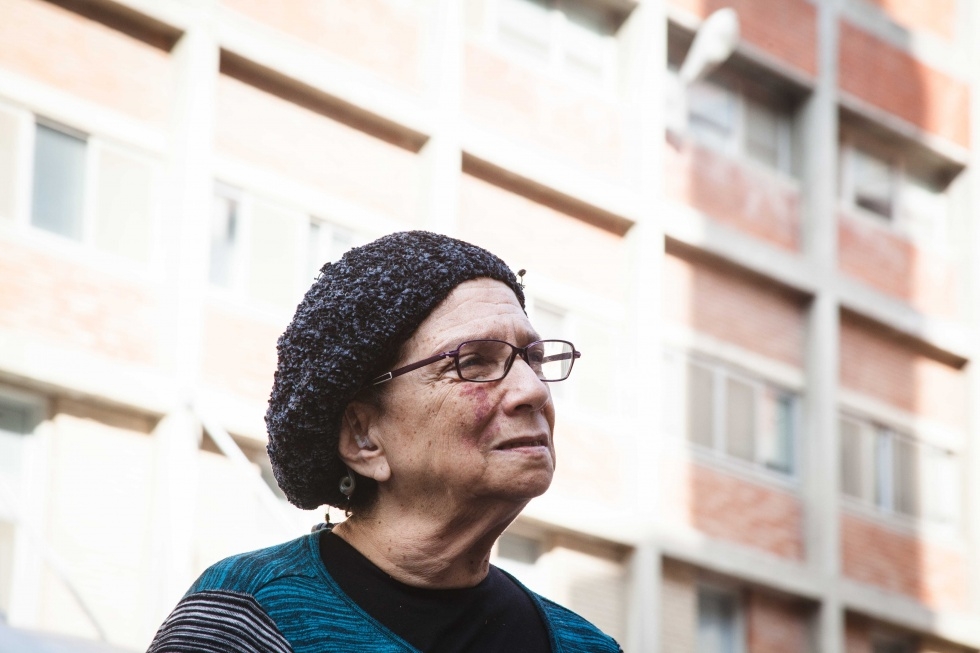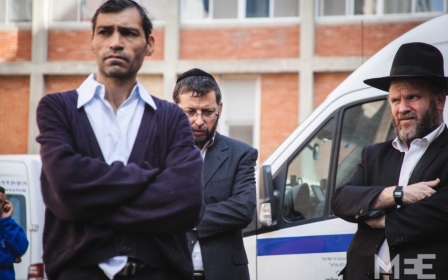After synagogue attack, a community is ripped apart in one short day

The news first rang out across the Har Nof neighbourhood around 7 am on Tuesday.
At 7.05 am, Sepora Heller heard a frantic knock at her door. When she went to open it, her 12-year-old grandson stood screaming, covered in blood.
“The Arabs have gone into the synagogue,” he shouted at her as he ran inside.
“They came with guns and axes,“ she recalled her grandson saying. “They are killing everyone.”
Before long, news of the attack spread, although it would be at least an hour before the relatives of those injured and killed found out exactly who had been hit and who had made it out alive.
Heller’s son-in-law and the boy’s father, Shmulik Goldstein, was one of the unlucky ones. Wounded in the head and abdomen, he was rushed to the Hadassah Medical Center where he remains in critical condition.
The incident was beyond belief, Heller later explained. The day started out like any other. Like most mornings, the Kehilat Bnei Torah synagogue was busy with dawn worshipers milling in and out.
Despite security being beefed up in the city in the wake of several recent attacks and clashes, the violence had shaken but not directly reached West Jerusalem. The gates of the synagogue were not guarded and there wasn’t a particularly heavy police presence on the streets.
Shortly before 7am though that all changed when two men, armed with axes, knives and guns, approached the synagogue.
It’s unclear whether they began attacking people just outside the building or if they waited until they entered. Once inside, however, violence was swiftly unleashed.
Shots were fired, and worshippers indiscriminately attacked with an axe. People either hid or ran for their lives, leaving a trail of blood, clothes and belongings as they fled.
According to medical sources, the two attackers - Ghassan Abu Odai, 23, and Odai Abu Jamal, 30, cousins from East Jerusalem – took particular care to aim at people’s heads and necks, presumably to inflict the most amount of damage.
"We received four severely wounded patients. All of them are either gunshot wounds, or wounds that are associated with the wounds from a machete. All of them have some kind of head injury,” said Professor Yoram Weiss, Medical Director of Hadassah Medical Center that is treating many of the injured.
According to Mati Goldstein, a spokesperson for Zaqa, a community of voluntary emergency response teams in Israel, the people inside the synagogue fought back, throwing chairs and other objects at the attackers, trying to hold them off before the authorities arrived.
When police entered the building, a gun battle ensued. By the time the guns fell silent, four Israeli worshipers were dead and eight others wounded, including a policeman who was still in surgery at the time of writing. The two attackers were shot dead by police.
Moshe Twersky, 59, a dual US-Israel citizen; Arieh Kupinsky, 43, a dual US-Israel citizen; Kalman Levi, 55, a dual US-Israel citizen and Avraham Goldberg, 68, a dual Israel-UK citizen, have since been named as the four Israelis. Twersky was a well-known rabbi among the Haredi Anglo-Saxon community in Jerusalem; his lessons were popular.
Joyce Morel, a Canadian immigrant and volunteer with United Hatzalah, a national emergency medical service, was one of the first emergency responders on site.
“It was extremely upsetting to see seriously injured people just near a shul [synagogue] like that,” she told Haaretz. “The gentleman I tended to first still had his tefillin [phylacteries] on.
“There were also women there who didn’t know where their husbands were, and others who didn’t know where their father was. Those were most likely the ones killed. It was very hard to deal with, very upsetting.”
As the families darted to the hospital to be with their loved ones, residents slowly turned up to find out what had happened. They were greeted by crews of police, ambulance and emergency workers who had all flocked to Har Nof.
About a hundred men looked on at the blood stains that smeared the pavement before emergency crews started what would be an hours-long clean-up process.
The bodies were eventually carried out at 10:30 local time - by then in full view of the world’s media, even though it would be several more hours before reporters were allowed into the synagogue to survey the damage.
Oren Ziv, MEE’s contributor on the ground, was one of the first to enter the building.
“Zaqa had cleaned it up very carefully. Under Jewish belief, the blood, the clothes, it all belongs to the dead and wounded,” he said by telephone.
“By the time we entered around 1pm, it was clean, but you could see a lot of bullets on the wall. It was hard to see who the bullets belonged to and whether they had been fired by the police of the Palestinian attackers.
“There were a lot of bullets around the main door and the entrance but also inside on the bookshelf holding the holy books. Lots of glass had been visibly broken,” he added.
Around lunchtime, police briefly allowed residents to enter the synagogue where they lit candles and prayed, although it was then closed by police ahead of the mass funeral held for three of the Israeli victims.
“The funerals were not made into a political event. There were no politicians, just family members and friends who gathered and gave short religious readings to honour the dead,” Ziv said.
As night fell, the synagogue and surrounding area were visibly altered, with a new found heavy police presence, backed by a straggle of reporters piecing together the events that ripped a community apart in the space of one short day.
Goldstein's family meanwhile was still holding their breath.
Additional reporting by Andrea DiCenzo and Oren Ziv.
New MEE newsletter: Jerusalem Dispatch
Sign up to get the latest insights and analysis on Israel-Palestine, alongside Turkey Unpacked and other MEE newsletters
Middle East Eye delivers independent and unrivalled coverage and analysis of the Middle East, North Africa and beyond. To learn more about republishing this content and the associated fees, please fill out this form. More about MEE can be found here.






